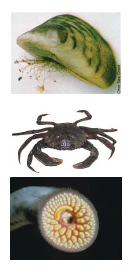Water: Middle School
Exercise IV. Exotic Invasive Stowaways
Want to know more about exotic invasive species?
More information on this topic can be found at the following Web sites:
The Gulf of Maine Council on the Marine Environment
Minnesota Sea Grant's guide to invasive exotic aquatic species
Dangerous Stowaways

Some boating-related environmental problems have nothing to do with the chemicals released by boat motors or the solvents used to clean boats. Sometimes simple plants and animals can be a big problem.
Large cargo boats often take on ballast water after unloading large loads. This water is transported to the next port and released when a new cargo load is placed on the boat. Because the boats take on untreated water directly from outside the ship, they often pick up plants and animals with the water. These plants and animals are then released in a new location when the water is let out. These exotic (meaning from another area) aquatic species can travel across the world in this way. When released in a new location, sometimes the plants or animals die immediately because of different water conditions; for example, the water might be too cold for them at the new location. Other times the species grow and reproduce rapidly because there is no natural predator to keep the population under control. Species that do well in a new location are known as exotic invasive species, and they can be very hard to control.
Choose one of the species of concern in the article "Ballast Water a Vehicle for Exotic Marine Species Invasions" or pick a species of concern in your local area.
Report your findings on the nature of the species, where it is found, and where it came from. Also include the ecological disturbance that it has caused. In your report, you might want to include a picture of the invader or a map of the world indicating with arrows how the exotic species got to its new location.
